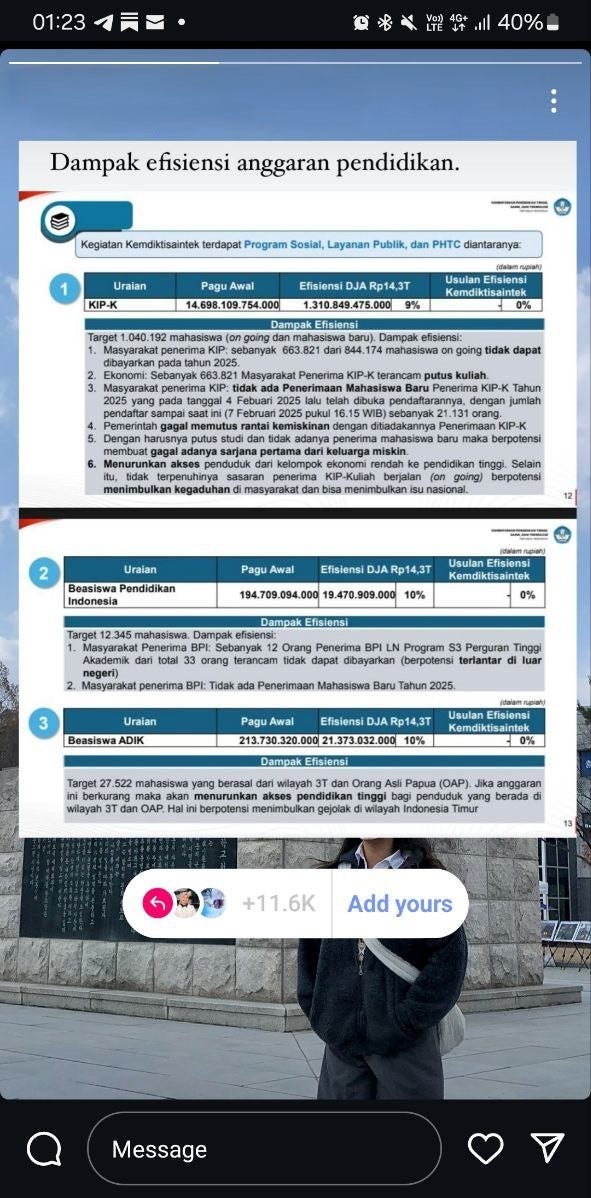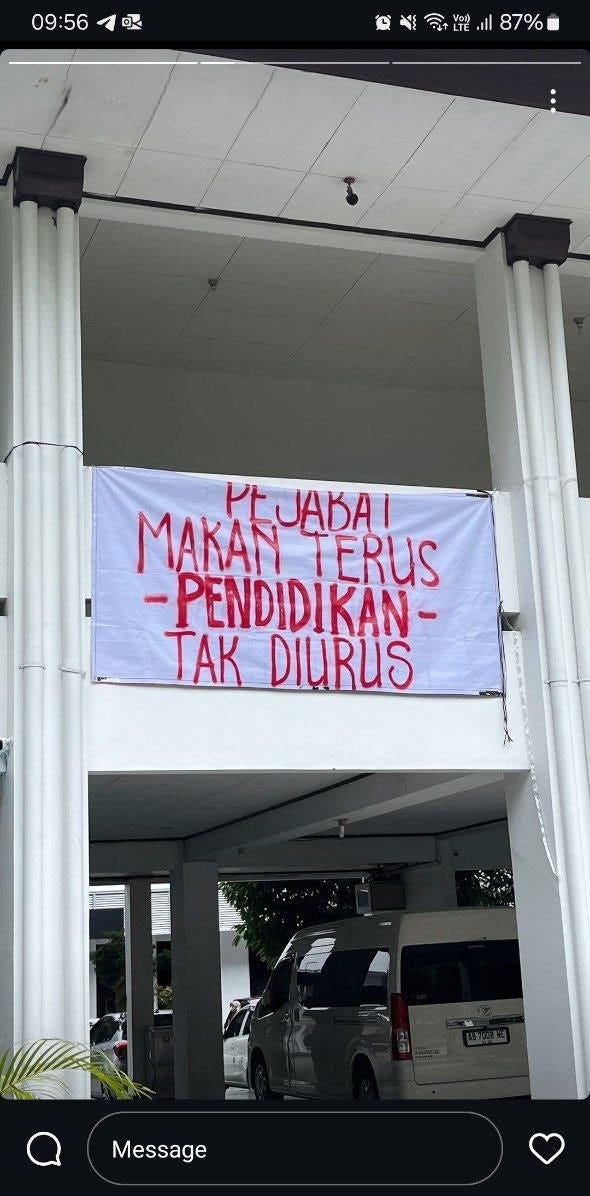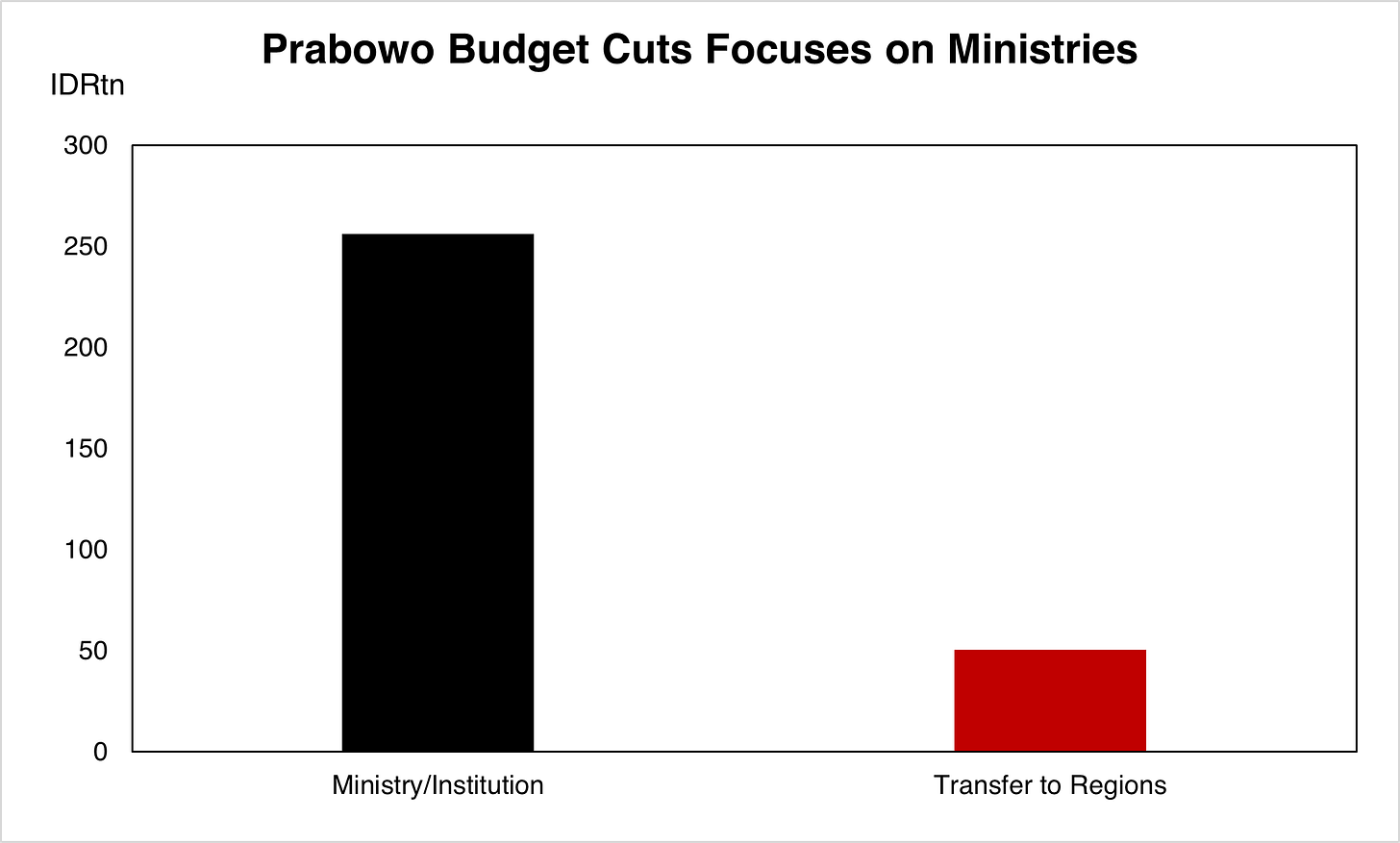Death by a Trillion Cuts: Prabowo's Austerity Makes No Sen
Why feed children lunch but remove their parents' ability to give them dinner?
Prabowo’s deep budget cuts have been controversial, with the former Defense Minister choosing to axe spending in crucial Ministries. Unlike Millei’s efforts in Argentina or Musk’s burgeoning efforts in the US, Prabowo is not looking to cut spending to correct fiscal imbalance. Instead, these cuts stem from the desire to push through populist measures which have questionable efficacy.


The recent budget cuts in the name of “efficiency” have sparked some discontent in the educated youth of Indonesia. The top image is a viral screenshot showing the apparent inefficiency in the Indonesian education system. Where even enrolled students are not graduating. The bottom image shows a banner at the University of Gajah Madah’s Faculty of Social and Political Sciences. The banner directly criticizes politicians who “keep eating” while the education sector is “not managed” properly.
Although Gajah Madah is a PDIP stronghold, the timing of minor protests and digital activism suggests Prabowo’s budget cuts face some grassroots opposition.
We will cover the recent budget cuts through 3 main points. First, we will try to understand why Prabowo is choosing austerity. Second, we will look at what spending is being cut and what that means for Indonesia. Third, we will look at we will look at what the budget savings are being used for
Why Austerity?
Before his handover, budget cuts and Prabowo were rarely mentioned together—especially since his cabinet, now at a record 48 ministers, is the largest ever. To fund his populist measures, Prabowo had three options: take on debt, raise taxes, or cut spending. He seemingly attempted the first two before resorting to budget cuts
Prabowo likely looked to increase Indonesia’s debt initially, as evidenced by his stated desire to raise the debt limit to 50% of GDP and appointing his nephew as deputy Finance Minister. However, a post-election sell-off of the IDR and IndoGBs signalled market concerns over excessive borrowing. In fear of rattling the asset markets, Prabowo appointed known fiscal disciplinarian Sri Mulyani to reassure investors. We covered this in “Prabowo’s Cabinet Give Hints on Policy Goals”.
The tax hike route was also explored through the VAT hikes. Although initially signed into law by Jokowi’s administration, the VAT hike from 11% to 12% was hoped to raise sufficient revenue to offset the cost of Prabowo’s campaign promises. Indonesia’s low tax collection rate is a known structural issue, as its tax revenue as % of GDP has been consistently lower than its ASEAN peers. However, after significant pushback from the Indonesian public, the Prabowo administration chose to roll back these hikes and kept the VAT hikes to luxury goods.
(Note: The VAT hike roll back is quite interesting. Since the hike was written into law during Jokowi’s Administration, some creative accounting had to be done to allow the DPR to stop the hike without violating the law. WhatsUpIndonesia has an amazing post on it and they bring up a good point on how this erodes trust in the law)
Since debt-taking and higher taxes are not a viable option, Prabowo defaulted to spending cuts to fund his campaign promises.
This solution, of course, is largely accepted by the bond market as the 10y IndoGB saw its yields fall by 170bps. To bond traders, budget cuts were ideal as they assured them that the Indonesian government’s creditworthiness is preserved, especially since Sri Mulyani is in charge. From this perspective, the austerity measure is logical and the best course of action. If that is the case, why would we view these spending cuts so negatively? It is down to what was cut and by how much.
Who Got the Cuts?
According to Prabowo, the cuts were meant to increase “efficiency” and reduce wasteful spending. He even went so far as to call administrators who opposed the cuts “raja kecil” or little kings who felt like they were immune to the law.
“I want to save the money for the people, to feed the people’s children. I want to fix all Indonesian schools,” - Prabowo
In the same speech at the 18th Congress of Muslimat Nahdlatul Ulama, he says that he aims to “save money” through cutting business travelling. Of course, we now know that this was not all that he cut.

According to Inpres No.1 Tahun 2025, Prabowo ordered IDR306.7tn (USD18.8bn) of cuts or approximately 8.5% of the total 2025 budget. He has since announced that a second phase of cuts will likely go through. This time, it will be IDR308tn, with an additional >IDR100tn coming from dividends from State-Owned Enterprise. This will bring total spending cuts to IDR750tn.
For phase 1, transfer to regions, which include funds for villages and autonomous regions, will amount to IDR50.595tn. On the other hand, ministries and agencies will see a whopping IDR256.1tn worth of cuts. Troublingly, the decisions on budget cuts are split down ideological lines. Prabowo appears to spare ministries which are crucial power bases while piling the pressure on ministries helmed by politically insignificant actors.
Ministries who got spared are power brokers
Of the 48 ministries, only 16 will be spared from the cuts and most crucially these 16 are seen to be the most important for Prabowo to stay in power. So far, it is known that the House of Representatives (DPR), Ministry of Defense, National Police, Coordinating Ministry for Political and Security Affairs and the National Nutrition Agency are spared.
The DPR was likely spared as he required it to be on his side for the rest of his administration. His coalition, the KIM-plus, controls more than 80% of the seats in the DPR with only the PDI-P being the final holdout. Unlike previous presidents, Prabowo have enjoyed great support which enabled him unparalleled power to shape Indonesia as he sees fit. So far, the only restraint on him has been a public uproar over unpopular policies and large volatility in asset markets. We view the move to spare the DPR as one that is meant to shield his greatest supporters from austerity to maintain his influence.
The Ministry of Defense, National Police and Coordinating Ministry for Political and Security Affairs are also notable exceptions to the austerity measures. It should be noted that Prabowo was formerly the Commander of the Indonesian Special Forces. Much of his initial political influence stems from his popularity amongst soldiers which gave him the “strongman” image that shaped his early political branding. Prabowo was also the Defense Minister under Jokowi, a role which caused him to butt heads with Finance Minister Sri Mulyani over what he deems as military underfunding. Prabowo needs to retain the favour of the large Indonesian military and police regime to maintain his support base while ensuring that the military complex remains subservient to the civilian government. Again, the lack of budget cuts seems less motivated by needs and more by political wrangling.
Ministries most affected are not politically significant
Agencies most affected by austerity have been the Ministry of Public Works (Cut 80% of budget), Ministry of Women Empowerment and Child Protection (Cut >50% of budget), Ministry of Primary and Secondary Education (Cut 25% of budget) and Coordinating Ministry of Economic Affairs (Cut 52.5% of Budget).
It is impossible to cover all ministries being cut but we would highlight two, the Ministry of Public Works and the Coordinating Ministry of Economic Affairs.
The Ministry of Public Works has been hit the hardest, as it is forced to furlough nearly 18,000 workers and, more concerningly, cancel 47,000km of highway maintenance. Such measures are strikingly harsh as public sector workers report that they are forced to work without the lights on and are forced to leave office by 4 pm. Why did this particular ministry bear this burden so greatly? Telok Ayer opines that this is evidence of Prabowo’s power play and signals his attempts at politicking.
First, it should be noted that the Ministry of Public Works is in charge of building Jokowi’s New Capital (IKN) at Kalimantan. Such vicious cuts signal some reluctance to complete what is essentially a vanity project. Second, we also note that the Ministry of Public Works is helmed by Dody Hanggodo, a relatively unknown businessman who is part of the Democratic Party. This allows Prabowo to put the burden of spending cuts on him without the fear of losing support from prominent backers. After all, the Democratic Party originally supported Anies Baswedan for Presidency. The Public Works have been, unfortunately, caught in the crossfire of Prabowo’s attempts at establishing some independence from Jokowi while ensuring that the cost is minimal.
The Coordinating Ministry of Economic Affairs is also likely a victim due to politics rather than the genuine need to cut wasteful spending. It is puzzling that Prabowo, who declared the growth target to be 8%, is also trying to defund the very Ministry that is supposed to make that happen. Minister for Economic Affairs Airlangga’s lack of political capital is likely why Prabowo is comfortable with cutting the ministry’s budget.
The way we see it, we need to be cognizant that Prabowo, and many other ambitious Indonesian politicians, are not rooted in an ideal or ideology but in power and influence. Ultimately, with Airlangga being forced out of the Golkar Party and with no strong supporters to count on, he has little recourse and has to reluctantly accept the budget cuts. The budget cuts are pragmatic tools of punishment which have little basis in spending optimization.
With the Phase 2 cuts imminent, we will be on the lookout for ministries helmed by Ministers with little to no political clout and/or Ministers from parties that only joined Prabowo’s coalition when it was clear that he was going to win.
What Are All These Savings Spent On?
The Phase 1 Budget Cut will immediately allocate to 2 major immediate spending needs. The first is Prabowo’s Free Meal Program (Makan Bergizi Gratis, or MBK), which aims to feed more than 80 million kids. This policy has been extremely popular due to drastic childhood stunting due to malnutrition in Indonesia. However, its efficacy has been heavily questioned. The second is to make up for the lost revenue from the administration’s decision to forgo the planned VAT hike in Jan 25.
It is not often that Telok Ayer criticises welfare projects, but from our vantage point, the MBK makes little sense. Fulcrum published a great article regarding the effectiveness of the MBK. We agree with the main points, Indonesia has a nutrition problem, not a food problem. Within the country, many children are underweight, overweight and nutrition deficient, and the solution to each will be drastically different. The MBK is being too general which means that the “triple burden of malnutrition” is not addressed and could worsen the situation. Experience from Chile, suggests that unless undernutrition is the only problem in children, a blanket food program will lead to poorer health outcomes.
The execution has also been incredibly problematic. The MBK has seen multiple cases of food poisoning in children, abrupt delays or suspensions of the free meal service, and poor-quality food. As seen below, redditor /u/obeytime shares his MBK meal on the Indonesian subreddit. Many Indonesian Redditors remarked that the food resembles “prison food” and pointed out that it is of poor nutritional content.
The VAT u-turn has also been factored into budget reallocation as the original IDT71.8tn in projected annual revenue is now not available. Instead of raising other taxes, the Prabowo administration has sought to trim spending. Of all the actions discussed today, this is probably the most agreeable one.
What is much less agreeable is the unexplained IDR134.89tn in funds being unallocated which represents nearly half of the total Phase 1 cut. Telok Ayer believes that such a significant amount of unallocated funds is indicative that this level of cuts was not necessary in the first place. This is a troubling possibility as a lack of reallocation may result in downside risks for Indonesia’s 2025 growth figure.
A potential use for this IDR134.89tn unallocated funds could be to inject capital into Indonesia’s new sovereign wealth fund Danantara. However, since Prabowo announced that the additional injection will amount to USD20bn (~IDR300tn), the leftover from the austerity measures will be insufficient to cover such an injection.
Phase 2 cuts will also look at IDR308tn additional cuts with IDR219tn being use to fund the expansion of the MBK. IDR58tn will then be redistributed back to the ministries with the final IDR31tn being, again, unallocated.
After breaking down the austerity measures from a macro lens, it is quite clear that the deep budget cuts are somewhat unnecessary. To be clear, cutting down on bureaucracy, increasing public sector productivity and reducing deficit spending are all noble goals. However, without any clear plan or larger strategy, the budget cuts are now beginning to look impulsive and reactionary. Much like this administration’s U-turn on the 3kg LNG sale restriction and VAT hike, current policymakers appear to be implementing a “guess-and-check” method of governance. They look to enact sudden, poorly-thought-out policies before backtracking on public pressure.
Conclusion
Throughout researching and writing this piece, a frequent theme has been clear in Prabowo’s administration. Power retention and politicking are the main focus of every relevant party. Of course, this is not new, but what is new is the lack of opposition pushback that forced the incumbents to at least present a somewhat logical proposal.
Against this backdrop, Indonesian students have started taking to the streets under the #IndonesiaGelap (Dark Indonesia) hashtag. Amongst other concerns like democratic backsliding, students have been protesting against the austerity measures. They point out that the victims of these budget cuts have been the common workers as they lose jobs or are forced into poor working conditions to save money. Ministers and high-ranking officers are still seen to be partaking in excessive spending by the public.
Although Finance Minister Sri Mulyani has declared that austerity will also continue in the 2026 budget plan. Prabowo has been remarkably responsive to public and market sentiment which might mean that austerity measures could be reversed.
One thing is for certain, the rest of Prabowo’s administration will be one of impulsive domestic policymaking followed by meek backtracking upon public pushback.







